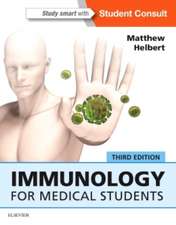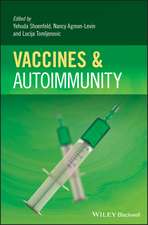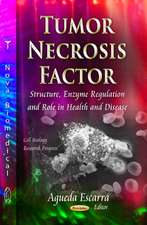Contemporary Topics in Immunobiology: Immunobiology of Oncogenic Viruses: Contemporary topics in immunobiology, cartea 6
Editat de Michael Hannaen Limba Engleză Paperback – 26 apr 2012
Preț: 368.37 lei
Preț vechi: 387.75 lei
-5% Nou
Puncte Express: 553
Preț estimativ în valută:
70.51€ • 73.33$ • 59.08£
70.51€ • 73.33$ • 59.08£
Carte tipărită la comandă
Livrare economică 14-28 martie
Preluare comenzi: 021 569.72.76
Specificații
ISBN-13: 9781468430530
ISBN-10: 146843053X
Pagini: 304
Ilustrații: XIV, 290 p.
Dimensiuni: 152 x 229 x 16 mm
Greutate: 0.41 kg
Ediția:Softcover reprint of the original 1st ed. 1977
Editura: Springer Us
Colecția Springer
Seria Contemporary topics in immunobiology
Locul publicării:New York, NY, United States
ISBN-10: 146843053X
Pagini: 304
Ilustrații: XIV, 290 p.
Dimensiuni: 152 x 229 x 16 mm
Greutate: 0.41 kg
Ediția:Softcover reprint of the original 1st ed. 1977
Editura: Springer Us
Colecția Springer
Seria Contemporary topics in immunobiology
Locul publicării:New York, NY, United States
Public țintă
ResearchCuprins
1 Comparative Immunology of Carcinogenesis by DNA Viruses.- I. Introduction.- II. Properties of Oncogenic DNA Viruses.- III. Oncogenic Potential of DNA Viruses in Vivo.- IV. Oncogenic Potential of Defective Genomes.- V. Neoplastic Transformation in Vitro by DNA Viruses.- VI. Role of Virus Genome in Cell Transformation.- VII. Antigens Associated with DNA-Virus-Transformed Cells.- VIII. Genetic Origin of DNA-Virus-Specified Antigens.- IX. Immune Response of the Host to DNA-Tumor-Virus-Induced Antigens.- X. Role of DNA-Virus-Induced Antigens in Neoplasia.- XI. Conclusions.- XII. References.- 2 Immunity to Leukemia, Lymphoma, and Fibrosarcoma in Cats: A Case for Immunosurveillance.- I. Introduction.- II. Immunosurveillance Hypothesis.- III. Feline Oncornaviruses.- IV. Feline Oncornavirus-Associated Cell Membrane Antigen.- V. Laboratory-Induced and Naturally Occurring Tumors of Cats.- VI. Immune Response to Laboratory-Induced Tumors.- VII. Immune Response to Naturally Occurring Leukemia and Lymphoma.- VIII. Summary and Conclusions.- IX. References.- 3 Intracellular and Systemic Regulation of Biologically Distinguishable Endogenous Type C RNA Viruses of Mouse Cells.- I. Introduction.- II. Evidence for Three Classes of Biologically Distinguishable Endogenous Mouse Type C Viruses.- III. Differential Activation of Endogenous Viruses.- IV. A Gene Affecting Expression of Class I Virus.- V. A Gene Influencing the Magnitude of Release of Class III Endogenous Virus.- VI. Susceptibility to Exogenous Infection of Mouse Cells by Xenotropic Virus.- VII. High-Titered Neutralizing Activity Directed Against Xenotropic Virus in Normal Mouse Sera.- VIII. Activation of Type C Viruses from Lymphoid Cells Following Antigenic Stimulation.- IX. Biological Functions of Endogenous Type C Viruses.- X. References.- 4 Mammalian C-Type Oncornaviruses: Relationships between Viral Structural and Cell-Surface Antigens and Their Possible Significance in Immunological Defense Mechanisms.- I. Introduction.- II. Morphology of Mammalian C-Type Viruses.- III. Isolation and Physicochemical Characterization of Structural Polypeptides of Murine and Feline Viruses.- IV. Antigenic and Other Biological Properties of the Structural Polypeptides.- V. Localization of the Virion Proteins and Glycoproteins in the Particle Structure.- VI. Viral Structural Antigens on the Cell Surface.- VII. Autogenous Immunity in Mice to Viral Structural Antigens.- VIII. Immunogenic Potency of Isolated Viral Proteins and Glycoproteins.- IX. Seroimmunotherapy of C-Type Virus Infections.- X. Concluding Remarks.- XI. References.- 5 Natural Immunity to Endogenous Oncornaviruses in Mice.- I. Introduction.- II. Widespread Occurrence of Natural Antibodies to MuLV.- III. Characterization of the Immune Response.- IV. Virus Specificity.- V. Autogenous Humoral Response to Virus-Induced Cell-Surface Antigens.- VI. Discussion.- VII. References.- 6 Biological and Structural Pleomorphism of the Oncornavirus Envelope Glycoprotein, gp70.- I. Introduction.- II. MuLV gp70 Is a Surface Component of Virus Particles.- III. MuLV gp70 Is a Surface Component of Infected Cells.- IV. MuLV gp70 Is a Component of the Surface of MuLV-Induced Lymphomas.- V. MuLV gp70 May Be Expressed in Normal Cells.- VI. Host Functions and Viral Genes.- VII. References.- 7 Autoimmunity, Oncornaviruses, and Lymphomagenesis.- I. Introduction.- II. Immunological Activation of C-Type Viruses.- III. Virus-Induced Autoimmunity and Lymphomagenesis.- IV. Discussion.- V. Summary.- VI. References.- 8 Natural Immunity to Murine Mammary Tumor Viruses.- I. Historical Review.- II. Immunofluorescence Studies on the Presence of Antibodies to MTV in Mouse Sera.- III. References.- 9 Immunogenicity and MuMTV-like Antigenicity of Human Breast Cancer Tissues.- I. Introduction.- II. Immunogenicity of Human Breast Cancer.- III. Immunological Measurements.- IV. Physicochemical Measurements.- V. Comments.- VI. References.- 10 Clinical Implications of Immunity to Oncogenic Viruses.- I. Introduction.- II. Etiology.- III. Prevention.- IV. Immunodiagnosis.- V. Therapy.- VI. Summary and Conclusions.- VII. References.






















